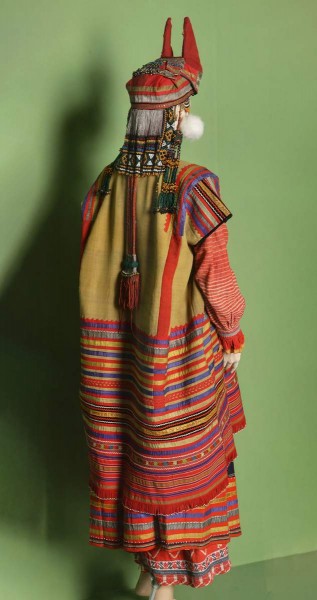Female Festive Costume
Bogoslovshchina, Mikhailov District, Ryazan Gubernia. Mid-19th century
- Fabric, spangles, passementerie, silk, beads, stitching on cardboard, red calico, wool threads, metal thread, embroidery, stringing, cotton and hemp fabric, swansdown, silk ribbons, hemp, wool, cotton fabric, flax and cotton threads, weaving, lace, ribbons, braid
- В-3040; В-5161; В-5137; В-7883к; В-5138; Т-771
Headdress ‑ Horned Kichka
Fabric, spangles, passementerie, silk, beads, gold embroidery on cardboard
Pozatylen (back part of a headdress)
Fabric, red calico, silk, passementerie, wool thread, metal thread, spangles, beads, embroidery, stringing
Ryasnas
Silk, beads, passementerie, cotton and hemp fabric, stringing
Floss Balls
Swansdown, silk ribbons
Braid (Snur)
Hemp, wool, beads, cotton fabric, stringing
Shirt
Flax and cotton threads, weaving, lace
Ponyova
Wool, flax, passementerie, spangles
Zheltik, Nasov (outerwear)
Wool, weaving, ribbons, braid
Pushki are the floss balls of goose or swan down that adorned headdresses in Ryazan, Tambov and Tula Gubernias, as well as in other parts of Russia, hanging down by the temples and cheeks.
In the 17th century, Russian tsarinas wore a kika (kichka) headdress, decorated with diamonds, sapphires and emeralds. Strings of precious stones and pearls were suspended along the edge of the front of the kika, and ryasnas hung down close to the ears. P. I. Savvaitov compared these headdresses to the headwear of his contemporaries in the 1850s: “In some remote places, where the old customs are still observed, the peasants, and even the townspeople, can be seen wearing headdresses to this very day. These are sometimes horned, covered with braid and decorated with a variety of embroidery and beads. Those of the rich old women are even decorated with pearls and precious stones. This headwear is called a kichka in some places and a kokoshnik or soroka in others”. (Savvaitov 1896, 55–56).

